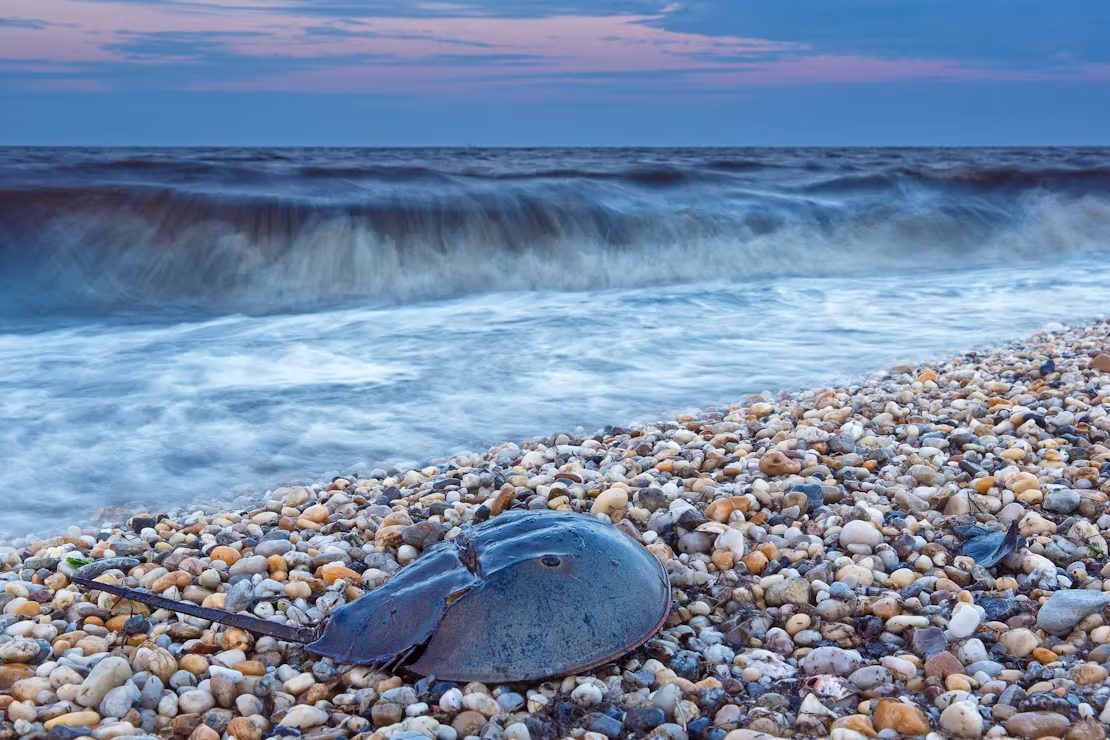If 2021 was a difficult year for the red knot, one of the world’s great migratory shorebirds, 2022 may be harder.
On the heels of the lowest red knot count since surveys began—fewer than 7,000 birds were documented in Delaware Bay this May—the Atlantic States Marine Fisheries Commission (ASMFC) appears poised to hasten the red knot’s decline by potentially lifting protections from the female horseshoe crabs of Delaware Bay.
Red knots rely on horseshoe crab eggs for fuel during their roughly 9,300-mile migration. They time their trip to coincide with the crab’s annual spawn, one of the East Coast’s most cherished wildlife spectacles. During a brief pitstop, each knot must consume roughly 400,000 nutrient-rich eggs before departing for the Arctic.
So great are the stakes, the birds that fail to acquire such reserves are less likely to survive and reproduce. Thus, if the horseshoe crab goes, so too does the red knot.
Today, horseshoe crabs are primarily targeted for use as bait by eel and whelk fishermen in Delaware Bay. The species is also bled by biomedical companies. Both industries are respectively managed by the ASMFC, a compact of states and industry interests.
By developing benchmark stock assessments, imposing quotas and regulating the bait harvest, the ASMFC has taken steps to redress historical overharvesting, which once saw the horseshoe crab ground into fertilizer paste in untold millions.
Despite these measures, the red knot has failed to bounce back. Between 2005 and 2014, the Delaware Bay red knot population was, on average, 70 percent lower than when surveys began in the 1980s. In 2013, the ASMFC attempted to address these continued declines by implementing the Adaptive Resource Management (ARM) framework.
The ARM model, it was argued, portended a future in which horseshoe crabs could be sustainably apportioned between birds and bait fishermen, while ensuring the continued viability of both. Under ARM’s statistical approach, there would be enough eggs for the birds, and enough crabs for industry.
After nearly a decade, however, those aspirations have gone unfulfilled. The southern wintering red knot population, the bellwether for the larger subspecies, continues to plummet. Delaware Bay egg densities remain at roughly a fifth of their historical carrying capacity, below what’s needed to facilitate the red knot’s recovery (Smith et al., In Review). Despite harvest prohibitions, there’s also been no meaningful recruitment in Delaware Bay females (Bi, Hata, & Hallerman, 2020).
Unprecedented emergency protection measures are plainly warranted, yet the ASMFC—in a dramatic reversal—is positioning itself to effectively throw in the towel on red knot recovery efforts.
Under the current framework, no female crabs can be harvested in Delaware Bay for bait until the female population reaches 11.2 million crabs or the total red knot stopover population reaches 81,900 birds. Neither metric has yet been attained.
Under the proposed management revision, 175,000 to 190,000 females could be harvested as soon as 2023 (Walsh, 2021). In reaching this decision, the ASMFC disproportionately relied on surveys it has long considered biased and of dubious accuracy, which “reduces the scientific credibility” of the proposed revision, according to committee members and former proponents of the ARM framework (Niles, Burger, Mizrahi, & Dey, 2021).
The only horseshoe crab-specific survey thought historically reliable—the Virginia Tech trawl survey—continues to indicate that female horseshoe crabs are in trouble.
For its part, the U.S. Fish and Wildlife Service (FWS), a member of the ASMFC, has stridently opposed the proposed changes. “There has been no change in the knot population, modest and uncertain growth in the crab population, and two highly aberrant stopover seasons in a row.”
The “risk and uncertainty are both too high for the resumption of female crab harvest at this point in time,” said FWS in a minority report, before opaquely alluding to the prospect for potential violations of the Endangered Species Act (Walsh, 2021).
Additional committee members put it more bluntly: “Horseshoe crab eggs and red knot populations have not increased during the 23 years of ASFMC management, including nine years of ARM Model management. The committee’s proposed management framework “suggests the need for horseshoe crab harvest is greater than the continued existence and recovery of red knots.” (Niles, Burger, Mizrahi, & Dey, 2021).
With climate change expected to degrade Arctic breeding grounds, biomedical pressure that has diminished the viability of southeastern staging areas and only a handful of beaches still supporting sufficient eggs in Delaware Bay, the southern wintering red knot population, at historically low numbers, is positioned for collapse if not extinction.
The adoption of the proposed revision would only push the red knot closer to the edge, in plain contravention of the ASMFC’s legal, scientific and ethical mandates.
The ASMFC will vote on this historic matter at its winter meeting on January 26. You can encourage the commission to reject the proposed revision at comments@asmfc.org and learn more from our partner Earthjustice, which submitted a detailed sign-on letter outlining the ASMFC’s potential legal shortcomings.
Bi, R., Hata, D., & Hallerman, E. (2020). Results of the 2019 Horseshoe Crab Trawl Survey: Draft Report to the Atlantic States Marine Fisheries Commission Horseshoe Crab and Delaware Bay Ecology Technical Committees (Rep.). Blacksburg, VA: Department of Fish and Wildlife Conservation, Virginia Polytechnic Institute and State University.
Niles, L., Burger, J., Mizrahi, D., & Dey, A. (2021). Minority Report to the Atlantic States Marine Fisheries Commission, ARM Subcommittee and Horseshoe Crab Management Board.
Smith, J., Dey, A., Williams, K., Diehl, T., Feigin, S., Niles, L. In Review. Horseshoe Crab Egg Availability for Shorebirds in Delaware Bay. Dramatic Reduction After Unregulated Horseshoe Crab Harvest and Limited Recovery after 20 Years of Management. Ecological Indicators, Elsevier.
Walsh, W (2021). Minority Report to the Atlantic States Marine Fisheries Commission, ARM Subcommittee and Horseshoe Crab Management Board.








